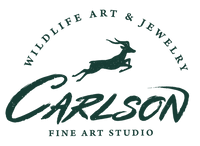
The concept for this painting is based on a large wild leopard that Laura Glen and I spent an entire afternoon watching in Africa’s Serengeti. With this concept I like the implied movement created by the intense gaze of the leopard looking out of the scene, allowing the viewer to wonder: what has attracted his attention?
At this first stage of the painting I start off by sketching in the concept using acrylic paint over a thin burnt sienna wash. By toning my canvas it will allow me to later gauge the painting’s values or (lightness or darkness of a color).

At this stage, I start laying in color. Most times I like to start my block in with the subject since all things will become relevant to the focal point.
My palette for this part mostly consists of yellow, raw sienna and burnt orange mixtures along with cool blue-grey mixtures in the shadows. This will allow the spots of the cat to really pop later.

At this point, I establish the color and shapes over the entire canvas that will become the foundation for the illusion of detail that is to come. By using a combination of warm and cool colors this will help to create the feel of sunlight in the painting.
I carefully establish the pattern of spots. This is often the most difficult part of painting a spotted cat. It is necessary to pay very close attention to the underlying curvature of the leopard’s muscle structure. Now, I will allow the painting a chance to dry and my brain much needed rest from seeing spots!

From here I continue to refine the painting, adding fur and grass textures. I love to work back and forth between a palette knife and brush at this stage to create a nice variety of textures like what is found in the thick African brush. I'm also beginning to consider a few title ideas.

Now for the "goodies"! Don't you wish you could just eat the dessert first! After all of the underlying layers are dry I can finally add the whiskers and overlapping grass setting the leopard into the scene and creating that depth and sense of life into the painting.
I have decided on the title "Extreme Ways", I think it is fitting representation of the life on the edge that these beautiful cats experience just to survive.
You can see the final original painting of "Extreme Ways" here.
Thanks for following me on this journey.


